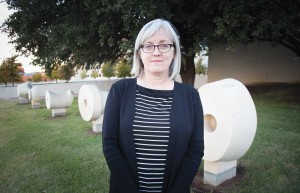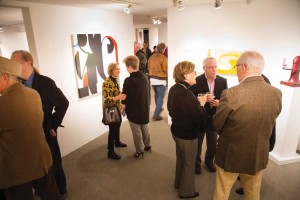“Contemporary art” is a wide umbrella term, of course, and the Campbells have shown many different styles –– abstract, conceptual, expressionist, and so-called pop art. They’ve generally avoided anything deliberately provocative a la Robert Mapplethorpe or Andres Serrano, a concession to the conservative climes of a city like Fort Worth.
But that doesn’t mean their art has been decorative or shallow. Many of the works they’ve showcased –– the tiny, eerily detailed sculptures of Robert McAn; the paintings of houses wrapped in cloth by Carol Benson — invite and reward closer scrutiny. William Campbell artists have been Fulbright Scholars and National Endowment for the Arts grant winners and shown their work at big-deal international venues like the Venice and Paris Biennales. Bill said that what interests him isn’t so much a particular style or school of contemporary art as it is the technique that the artists use.
“I think I’ve always been cognizant of process, the methods people use to create their art,” he said. “Maybe that’s because I studied sculpture. Sculpture is very process-oriented, and if the process isn’t there, it shows.”

Conn met the Campbells back in 1984. A TCU graduate who studied photography, she remembers keenly the sense of excitement in those days among local art fans, with the William Campbell Gallery at the center of the experience.
“The most important thing about Bill and Pam is that they are completely ego-less in an ego-driven business,” she said. “They were kind and very patient to college kids like me who didn’t know much about the art world. They’d take time to talk to you about the artists they represented, even if they knew you weren’t buying something.’
One of those artists is Grant, the Fort Worth painter whom the Campbells have represented since they saw his TCU graduate thesis show in 1992.
The connection with the Campbells didn’t develop immediately, however. They were skeptical about his earliest work.
“An acquaintance took me to their gallery to meet them and show my work,” Grant recalled. “All I had at the time were a few undergraduate images. They very gently suggested there wasn’t anything to look at. But they don’t automatically close access to anyone, because when they saw my graduate show at TCU, they immediately asked if they could represent me.”
Through the years, Grant and the gallery owners have become close friends; they called him and came to see him in the hospital when he got so sick three years ago from a neuromuscular condition that he could barely lift his arm to paint. The Campbells have been instrumental in his acclaimed career. They’ve helped arrange sales of his paintings to both individual collectors and corporations –– including the purchase of a small group of his most recent paintings by a collector in London. Fort Worth Weekly contributor Annabelle Massey Malloy has noted “the extraordinary use of light; earthy, rich color choices; and meticulous brushwork” in his vivid neo-classical portraits.

“What sets Bill and Pam apart is that they serve as agents for their artists, and that’s different from a lot of galleries,” Grant said. “Most galleries act as waystations for the work. They’ll promote your show, but that’s about it. Bill and Pam go further to make sure their artists are paid attention to. They contact collectors they think might be interested in your work, they send out images, and they take the time to tape video interviews to promote the artist.”
While the Campbells were building a stable of both Texas-based and Texas-connected artists, they were also cultivating a loyal following of buyers from around the city and, eventually, around the country.
Bill declines to reveal names, citing the ethics of discretion between gallery and collector. (“The bank manager never tells you who has how much in his bank,” he said with a laugh.) But William Campbell artists are in the permanent collections at the Kimbell, the Modern Art Museum of Fort Worth, and the Museum of Fine Arts in Houston; in the corporate collections of AT&T, Exxon, and Frost Bank; in family foundations like the Gund Collection in Boston and the Goode Collection in Washington, D.C.; and the personal collection of playwright Edward Albee.
It’s among smaller, less affluent collectors that the William Campbell has really made its mark, educating two generations of buyers in North Texas and later in New Mexico, California, Florida, and New York about Texas contemporary painting, sculpture, photography, and mixed-media. Bill said he’s seen the addictive nature of art collecting take hold in middle-class folks who don’t have a lot of discretionary income.
“Once people start collecting art for art’s sake, too much is not enough,” he said. “They’re not buying just to decorate their homes. There’s nothing wrong with buying art for decoration, of course –– we wouldn’t still be in business without that. But once people buy that first painting they love, it’s hard to stop. We’ve sold art to people who made a first down payment, then paid us so much per month for years.”
Alford has a theory about why the Campbells were able to establish and maintain a large following of small-time collectors –– Bill and Pam make the process simple and unintimidating.
“They allow buyers to collect what they want, but they guide you through the purchases based on your taste and price range,” he said. “There’s no attitude, and you don’t get the ‘used car salesman’ attack when you walk into the place. Not every gallery is like that.”
********
Even though they’re not quite ready to surrender their gallery to someone else’s ministrations, the Campbells have been pondering its future without them. Their son occasionally helped out at the gallery when he was young, but as an adult he chose to chart his career in a different direction. They definitely want the gallery to continue long after they’re gone and for others to carry on in nurturing the careers of upcoming artists and the tastes of newbie collectors.
To that end, they recently opened a small satellite gallery called ART7 Crockett Community Gallery in the thriving West 7th Street corridor. The idea was to create a contemporary art outpost in a hot new location that would attract a younger generation of both collectors and artists. Though ART7 Crockett is less than a half-mile from the main gallery, “In Fort Worth nowadays, a half a mile can make a big difference [if you want to reach a new audience],” Bill said.
About five years ago, they hired a young assistant named Sam Brown to help them run both the commercial and artistic halves of the William Campbell. Bill and Pam are impressed with her smarts and dedication, and they talk openly about handing the gallery over to her when they’re ready to take a smaller role and — probably years from now — step down. They’ll never retire completely, they insist, but they know someone else must be groomed if their Fort Worth contemporary art institution is to continue.
When they talk about the future, they sound a bit like people who, indeed, were young during a time far more laid-back than this one.
“We’ve never been good planners, the kind of people who think, ‘What are we going to do with the rest of our lives?’ ” Pam said. “We’re able to plan the next show, and that’s about it. Right now, we’re just dancing around the idea of retirement.”











